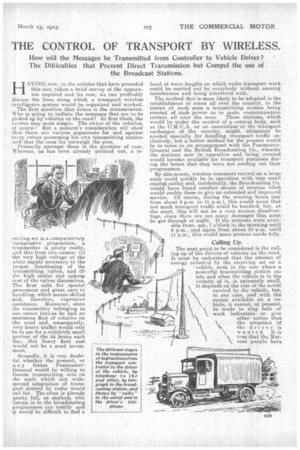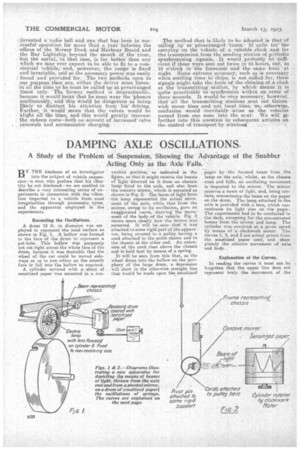THE CONTROL OF TRANSPORT BY WIRELESS.
Page 17

Page 18

If you've noticed an error in this article please click here to report it so we can fix it.
How will the Messages be Transmitted from Controller to Vehicle Driver ? The Difficulties that Prevent Direct Transmission but Compel the use of the Broadcast Stations.
AYING now, in, the. articles that have preceded this one, taken a brief survey of the appara tus required and its cost, we can profitably discuss the lines along which a transport wireless intelligence system would :_be organized and worked. • The first question that -Arises is the transmission. Who is going to radiate the messages that are to be picked up by vehicles on the road? At first blush, the answer 'may seem simple. The owner of the vehicles, of course I But a moment's consideration will show that there are various arguments for and against every owner possessing his own transmitting station and that the eons far outweigh the pros.
Primarily amongst these is the question of -cost. Whereas, as has been already pointed out, a re ceiving set is a comparatively inexpensive proposition, a transmitter is pretty costly, and this from two causes : (1) the very high voltage of the plate supply necessary to the proper functioning of the transmitting valves, and, (2) the high initial and upkeep cost of the valves themselves. The first calls . for special generators and great care in handling, which means skilled and, therefore, expensive assistance. Moreover,since the transmitter belonging to one owner (unless he had an enormous fleet of vehicles on the road and, consequently, very heavy traffic) would only be in use for a relatively small portion of•Ahe 24 hours each day, this heavy first; cast would, net be a good investment.
Secondly, it is very doubtful whether the present, or
n y future PostmasterGeneral would be willing to license transmitting sets on the scale which any widespread adaptation of transport control by radio would call for. The ether is alreadypretty full, as anybod5, -who listens in to the broadcasting programmes can testify -arid it would be difficult to find a band of wave lengths on which radio transport work could becarried out by everybody without causing interference and being interfered with.
The method that is most likely to be adopted is the establishment of zones all over the country, in the Centre of each zone a transmitting station being erected of such power as to make communication certain all over the zone. These stations, which would be under the control of a central body, such as the C.M.U.A. or an association' of the transport exchanges of the Country, might, ultimately be erected specially for handling transport traffic exclusively, but, a better method for the present would be to come to an arrangement with the PostmasterGeneral and the British Broadcasting Co., whereby the stations now in operation and being erected would become available for transport purposes during the hours that they were not sending out their programmes.
By this mean, wireless transport control on a large scale could quickly be in operation with very small capital outlay and, incidentally, the Broadcasting (Jo. would have found another means of revenue whch would enable them to give an extended and improved service. Of course, during the evening hours (say from about 6 p.m. to 10 p.m.), this would mean that not much transport traffic could be handled, .but, at the start, this will not be a very serious disadvantage, since there are not many messages that must be gat through at night. If the stations were avail
able from, say, 7 o'clock in the morning until 6 p.m., and again from about 10 p.m; until \ 11 pin., this would meet preSent needs fully.
Calling Up.
The next point to be considered is the calling up of the drivers of vehicles on the road. it Must be understood that the amount of energy collected by the receiving set on a vehicle, even in the • case where a powerful transmitting station exists and when the vehicle is in the vicinity of it, is extremely small. It depends on the size Of the aerial carried by the vehicle, but, in any ease, and with the means available on a vehicle,. it cannot, at present, be made to ring bells or work indicators or give other notice that ilae• attention of -the driver is wanted. It is true that the Marconi people have
\\\ invented a radio bell, and one that hasbeen in sueceSsful operation for more Chan a Year • between the offices of the Mersey -Dockarid-Harbour• Board and the Bar Lightship beyond the mouth of the river, but thá aerial, in that ease, is far better, than any which we may ever expect to be able to fit to a cornniercial vehicle, and, moreoverthe range is fixed and invariable, and so the necessary power was easily ; found and provided for. The two methods 'open to our purpose then -are, either the driver must listenin all the time iar he must be called' up at prearranged timed only. The '-former method is impracticable, because it. would incan that he must wear the 'phones continuously, • and this would be dangerous as being likely' to -distract his attention frail' his driving. tourther, it would .mean that the • valves would be a-light all the time, and -this Would greatiyincrease the upkeep costs—both 011: accourit.of increased valve renewals and accrimulator Charging. The method that is likely to be idopted is that of calling nri'at 'prearranged. •tinieS.• -It Tails" for the carrying on the vehicle of a reliable clock and for the transmission from the sending station of periodic synchronizing ,signals.. Jt would probably he-sufficient if these were sent out twice in 21 hours, saY; at 10 o'clock in the forenoon and the same hotir 'at night. Since extreme accuracy, such as is necessary when sending time to ships, is not called for, these signals might, take the form of the chiming. of ..a .clock at the transmitting station, •• by which: means it is quite practicable to • synchronize within an error of three seconds. It -would he-very necessary, however, that all the transmitting stations -sent out Greenwich mean time and not local 'time, •as,.. otherwise, confusion -Would inevitably .arise as the vehicles passed from OTka zone into the next: We will g6
further into this question subsequent articles on the control of transport by wireless
































